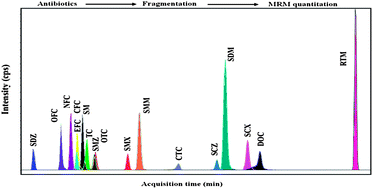Simultaneous extraction of four classes of antibiotics in soil, manure and sewage sludge and analysis by liquid chromatography-tandem mass spectrometry with the isotope-labelled internal standard method
Abstract
An analytical method for the analysis of four classes of antibiotics (tetracyclines, sulfonamides, fluoroquinolones and macrolides) has been developed and validated in this work. After optimizing the extraction and purification, the solvent consisting of a (EDTA-sodium phosphate buffer with acetonitrile : Mg(NO3)2-NH3·H2O, v/v, 3 : 1) was used as the extraction buffer, these antibiotics were extracted from agricultural soil, manure, and sewage sludge using ultrasonic-assisted extraction aided by mechanical shaking and followed by solid phase extraction (SPE) clean-up with hydrophilic–lipophilic balance (HLB) cartridges. The chromatographic separation was optimized, the analytes were separated and detected by liquid chromatography-electrospray ionization tandem mass spectrometry (LC-ESI-MS/MS) and quantified by the isotope-labelled internal standard method. Mass spectral acquisition was done in the positive ion mode by applying multiple reaction monitoring (MRM) of two fragmentation transitions per analyte to provide a high degree of sensitivity and specificity. The calibration range used for all the antibiotics was 5.0–300.0 μg L−1 and each calibration curve was linear with a coefficient of determination (R2) > 0.997, the instrument detection limits (IDLs) and quantification limits (IQLs) ranged from 0.09 to 3.57 and 0.49 to 11.9 μg L−1, respectively. Spiked recoveries were obtained in the range 60–140% for these antibiotics from three different matrices, with the exception of NFC and OFC in soil (52–55%). Lower relative standard deviation (RSD < 17%) for seven replicates from each matrix at 50 μg kg−1 spiking level and the method detection limits (MDLs) obtained in the ranges 0.5–14.8 μg kg−1 from soil, 0.5–14.1 μg kg−1 from manure and 1.3–17.3 μg kg−1 from sludge for all the antibiotics studied indicate that the method was reliable and sensitive for extraction and determination of the target compounds in soil, manure and sludge matrices. Finally, the method was applied to analyse soil, manure and sewage sludge samples. Fluoroquinolones were the most dominant antibiotics and there were smaller amounts of sulfonamides in the soil, sludge and manure samples collected.


 Please wait while we load your content...
Please wait while we load your content...